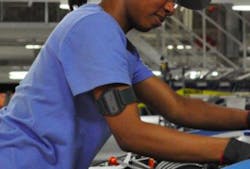It’s an age-old problem. How can workers be encouraged to report near-misses?
“Not all workers can participate in a near-miss reporting program,” explains Mark Frederick, Co-Founder of MākuSafe. “Many employees have specific goals they need to meet and even 10-15 minutes out of their day would throw them off. So, something they do notice often goes unreported.”
But what if they could literally talk into a device that they are wearing on their arm?
It’s possible and it’s happening at companies across the country.. MākuSafe provides a device that is worn on the arm that is equipped with a voice memo feature that allows workers to make note of either a dangerous situation or a potential hazard.
“At one of our pilot programs, we learned that on the first day that workers were equipped with the device, they were using it for this purpose,” says Frederick. “The memo goes to an EHS professional that can react immediately instead of waiting for the weekly safety meeting where many of these issues are discussed. It’s a real-time solution.”
The device has a variety of tools that takes a look at a number of physical conditions that are affecting employees. The device isn’t looking inward, such as taking biometric information about the employee but instead is measuring the environmental conditions.
The device monitors motion, location and environmental conditions such as sound exposure, air quality, heat and light.
“We explain the device is like having eyes and ears that are protecting them,” says Tom West, Strategic Relations Manager at MākuSafe.
West says that the availability of this information can lead to ways to decrease worker fatigue as well as increase productivity. He gave the example of a food processing facility where an employee was using a heavy piece of machinery to perform their job. The motion detector provided feedback to the EHS manager who realized that the level of effort needed to do this job might not fit all employees’ abilities and they are now examining the process.
The information from these devices goes into a cloud platform that classifies and categorizes the information. The company platform called MākuSmart displays safety data in an interactive format. It uses machine learning and artificial intelligence to search for trends, based on OSHA standards. For example, the system can identify a slip versus a trip versus a fall.
“Once you get beyond ensuring compliance you look for potential hazards and risks which allow safety leaders to gain insight, through data, into the issues that need to be solved,” said Frederick.
Results from Pilots
The company has conducted pilots in six different states across multiple industries including a steel foundry, commercial cleaning operation, food processing facility, and a packed good manufacturing company. Pilots were also conducted at worker’s compensation insurers policyholder sites.
Looking at data over the past four months involving 140 workers, 75,000 wearables hours and analyzing 300,000 indicators, and feedback from EHS managers at the pilot sites the companies reported over $600,000 in potential claims savings.
Part of the reason for the savings is the fact that this device can help change attitudes toward safety, says West. “This method of reporting the actual conditions that the worker is experiencing is bringing safety to another level. Safety leaders are able to see things that they weren’t able to before and can now have conversations in real-time to correct any situation. Addressing these issues so quickly sends a message that the company cares about their employees’ well-being.”
About the Author
Adrienne Selko
Senior Editor
Email [email protected]
Adrienne Selko is also the senior editor at Material Handling and Logistics and is a former editor of IndustryWeek.

